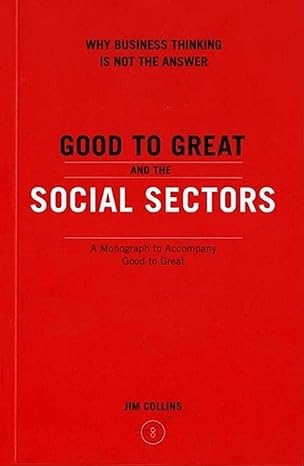Main Topic
“Good to Great and the Social Sectors” by Jim Collins explores how principles of business thinking can be applied to the social sectors such as government, education, and non-profit organizations to achieve greatness and positive societal impact.
Key Ideas or Arguments
- Level 5 Leadership: Collins emphasizes the significance of having leaders in the social sectors who possess humility, will, and an unwavering commitment to the organization’s mission.
- The Hedgehog Concept: The book introduces the concept of focusing on what an organization can be the best at, what drives its economic engine, and what it is deeply passionate about.
- Culture of Discipline: Collins argues that disciplined people, thought, and action are essential for greatness.
- The Flywheel Effect: The book suggests that transformation in social sectors is a gradual process, akin to pushing a heavy flywheel until momentum takes over.
- The Stockdale Paradox: Drawing from Admiral Jim Stockdale’s experiences as a prisoner of war, the book highlights the importance of confronting harsh realities while maintaining unwavering faith in eventual success.
Chapter Titles or Main Sections
- Good is the Enemy of Great: Explains the basis for the book’s principles.
- Level 5 Leadership: Introduces the concept of Level 5 leadership.
- First Who…Then What: Discusses the importance of getting the right people on board before deciding on direction.
- The Hedgehog Concept: Elaborates on the three circles of the Hedgehog Concept.
- A Culture of Discipline: Stresses the significance of discipline.
- The Flywheel and the Doom Loop: Introduces the Flywheel concept.
- From Good to Great to Built to Last: Explores how greatness can be sustained over time.
- The Social Sectors: Applies the book’s principles to the social sectors.
Key Takeaways
- Social sector organizations can achieve greatness by adopting business-like thinking without compromising their core mission.
- Level 5 leadership, a culture of discipline, and the Hedgehog Concept are crucial for success.
- Patience is essential, as greatness is a gradual process.
Author’s Background and Qualifications
Jim Collins is a renowned business consultant, researcher, and author known for his work on leadership and organizational performance. He holds an MBA from Stanford Graduate School of Business and has authored several influential books on management and leadership.
Comparison to Other Books
“Good to Great and the Social Sectors” is unique in its application of business principles to the social sectors. While other books discuss leadership and management, Collins’ work stands out for its practicality in non-profit and government settings.
Target Audience
This book is intended for leaders and decision-makers in the social sectors, as well as anyone interested in translating business principles into non-profit, government, or educational organizations.
Reception or Critical Response
The book has received widespread acclaim for its valuable insights into adapting business principles to the social sectors. It is considered a seminal work in the field of non-profit and government management.
Publisher and First Published Date
Published by HarperCollins in 2005.
Recommendations
- “Built to Last” by Jim Collins and Jerry I. Porras
- “Leaders Eat Last” by Simon Sinek
Biggest Takeaway
The biggest takeaway from “Good to Great and the Social Sectors” is that achieving greatness in social sector organizations is possible through Level 5 leadership, a culture of discipline, and the application of the Hedgehog Concept while maintaining unwavering commitment to the organization’s mission.



